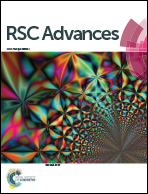Spin-polarized surface state in Li-doped SnO2(001)
Abstract
Using LDA + U, we investigate Li-doped rutile SnO2(001) surface. The surface defect formation energy shows that it is easier for Li to be doped at surface Sn sites than bulk Sn sites in SnO2. Li at surface and sub-surface Sn sites has a magnetic ground state, and the induced magnetic moments are not localized on the Li site, but spread over Sn and O sites. The surface electronic structures show that Li at surface Sn sites shows 100% spin-polarization (half metallic), whereas Li at sub-surface Sn sites does not have a half metallic state due to Li–Sn hybridized orbitals. The spin-polarized surface has a ferromagnetic ground state, therefore, ferromagnetism is expected in the Li-doped SnO2(001) surface.


 Please wait while we load your content...
Please wait while we load your content...